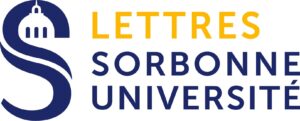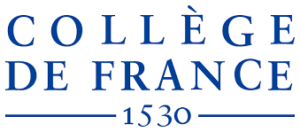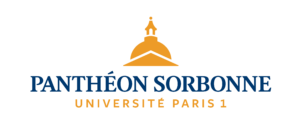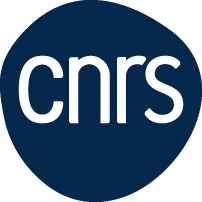Calligraphies en caractères arabes aux frontières du monde islamique du monde islamique
Le projet Calligraphies en caractères arabes aux frontières du monde islamique (CallFront) est consacré à l’étude des styles calligraphiques en caractères arabes nés dans la péninsule Ibérique, le Maghreb, l’Afrique subsaharienne, l’Anatolie, les Balkans, l’Inde, l’Asie du Sud-Est et la Chine.
Ce projet, dirigé par Eloïse Brac de la Perrière en collaboration avec Maxime Durocher, a été sélectionné par l’ANR 2022.
Un carnet de recherche recense les activités du projet et propose des publications régulières autour du projet : https://callfront.hypotheses.org/
Il est également soutenu par l’Institut national d’histoire de l’art, l’Observatoire des Patrimoines Sorbonne Université (OPUS), Barakat Trust et la fondation Max van Berchem.
The Calligraphies in Arabic Script at the Frontiers of the Islamicate World (CallFront) project is devoted to the study of calligraphic styles in Arabic characters born in the Iberian Peninsula, the Maghreb, sub-Saharan Africa, Anatolia, the Balkans, India, Southeast Asia and China.
This project, directed by Eloïse Brac de la Perrière in collaboration with Maxime Durocher, has been selected by the ANR 2022.
A research notebook lists the project’s activities and offers regular publications about the project: https://callfront.hypotheses.org/
It is also supported by the Institut national d’histoire de l’art, the Observatoire des Patrimoines Sorbonne Université (OPUS), Barakat Trust and the Max van Berchem Foundation.
Présentation :
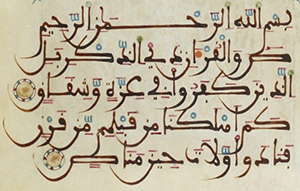
Coran, Maghreb, XIVe siècle
Durant les périodes médiévale et moderne, l’usage de la calligraphie en caractères arabes s’est étendu à toutes les langues transcrites en alphabet arabe et ses variantes, donnant naissance à une multitude de styles sur des supports variés.
Dans les territoires éloignés du berceau historique de la civilisation islamique où ont été établies les règles de la calligraphie arabe classique, les développements de ces formes écrites se distinguent du canon et suivent leurs propres règles. Les régions concernées sont ici dénommés « frontières » du monde islamique, à la fois en raison de cette distance géographique, mais aussi parce que ce sont des zones de contact avec d’autres communautés culturelles et linguistiques.
Pour documenter et comprendre la fabrication et l’usage de la calligraphie en caractères arabes dans l’ensemble de ces régions, sur un temps long, le projet Calligraphies en caractères arabes aux frontières du monde islamique (CallFront) vise à construire un corpus numérique pouvant être partagé par l’ensemble des chercheurs travaillant sur les problématiques liées aux écritures dans les régions couvertes par le projet. En rassemblant un consortium international de spécialistes dont les travaux ont porté sur ces écritures et une équipe de calligraphes professionnels, une étude de la praxis est menée sur la base de ce matériel commun.
Le projet CallFront s’articule autour de trois axes de recherche :
Axe 1 : Rassembler et décrire des corpus isolés à partir d’une ontologie partagée.
L’axe 1 vise à rassembler des corpus qui ont été étudiés séparément jusqu’à présent. Il s’agit d’établir des protocoles de description partagés, adaptés à une grande variété de styles calligraphiques.
Axe 2 : Documenter les calligraphies des frontières.
Pour pallier la rareté des informations dans la littérature sur la calligraphie, l’axe 2 vise à collecter deux types de documents : des sources conventionnelles mentionnant directement ou indirectement l’existence de calligraphies non canoniques (biographies, hagiographies, chroniques historiques), et des sources pratiques circulant dans les cercles de calligraphes (manuels, modèles de professeurs et corrections).
Axe 3 : Calligraphies et pratiques calligraphiques.
Nous ignorons quelles ont été les méthodes d’apprentissage et de transmission qui ont prévalu dans les processus de création de ces calligraphies. En l’absence de sources et de toute autre forme d’information à ce sujet, il est indispensable de recourir à de nouveaux protocoles d’analyse. Inspiré par des méthodes développées dans d’autres champs disciplinaires de l’histoire de l’art (P. Smith, Ways of Making and Knowing, 2017), CallFront s’appuie sur une collaboration étroite entre chercheurs et calligraphes professionnels.
During the medieval and modern periods, the use of calligraphy in Arabic characters spread to all languages transcribed in the Arabic alphabet and its variants, giving rise to a multitude of styles on different supports.
In territories far from the historical cradle of Islamic civilization where the rules of classical Arabic calligraphy were established, the developments of these written forms differ from the canon and follow their own rules. These regions are here referred to as the « frontiers » of the Islamic world, both because of this geographical distance, and also because they are areas of contact with other cultural and linguistic communities.
In order to document and understand the making and use of calligraphy in Arabic script in all of these regions over an extended period of time, the Calligraphies at the Frontiers of the Islamic World (CallFront) project aims to build a digital corpus that can be shared by all researchers working on questions related to the regional scripts covered by the project. Building on this common material, a study of praxis is conducted bringing together an international consortium of specialists whose work has focused on these scripts and a team of professional calligraphers.
The CallFront project is structured around three research axes:
Axis 1: Bringing together and describing isolated corpora using a shared ontology
Axis 1 aims to gather corpora that have been studied separately until now. The goal is to establish shared description protocols, adapted to a wide variety of calligraphic styles.
Axis 2: Documenting frontier calligraphies
To overcome the scarcity of information in the literature on calligraphy, axis 2 aims to collect two types of documents: conventional sources mentioning directly or indirectly the existence of non-canonical calligraphies (biographies, hagiographies, historical chronicles), and practical sources circulating in calligraphers’ circles (manuals, teachers’ models and corrections).
Axis 3: Calligraphy and calligraphic practices
We do not know what methods of learning and transmission prevailed in the processes of creating these calligraphies. Due to the lack of sources and any other form of information on this subject, it is essential to resort to new protocols of analysis. Inspired by methods developed in other disciplinary fields of art history (P. Smith, Ways of Making and Knowing, 2017), CallFront relies on a close collaboration between researchers and professional calligraphers.
